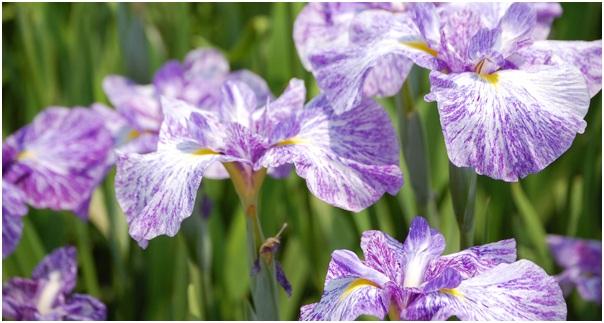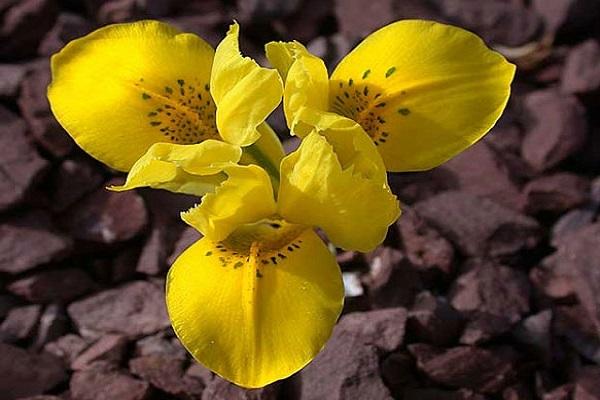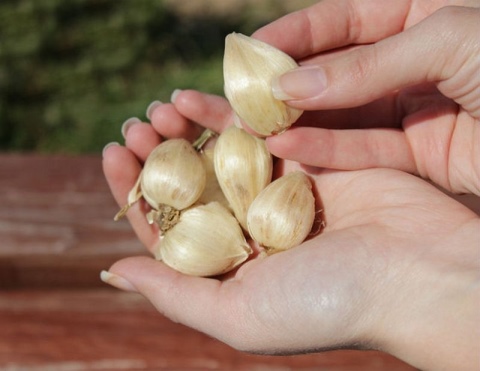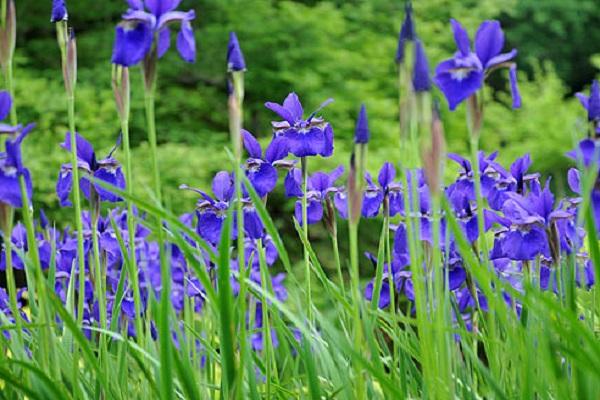Step-by-step technology of gardening
Step 1 - preparing the bulbs for planting
The scourge of any bulbous plants is fungal diseases. Therefore, before proceeding with planting, the iris bulbs need to be prepared.
Iris bulbs are examined for diseases and pests before planting.
You will need to inspect the planting material. It is better to throw out all bulbs with spots, rotting places. The rest should be treated with antifungal drugs. Fungicides "Fundazol" and "Maxim" have proven themselves well. Instead, a strong solution of potassium permanganate can be used to destroy the mycelium. The bulbs are kept for 30-40 minutes in the prepared solution, then dried and planting is started.
A solution of potassium permanganate has a disinfecting effect
Step 2 - preparing the soil
The land for planting will need to be dug up, if it is not moisture permeable enough - add sand, baking powder. Since bulbous irises are very sensitive to lack of nutrients in the soil, perennial compost should be added to its composition. Fresh manure is not used for bulbous, as it can cause fungal diseases.
Step 3 - correct fit
In the prepared soil, holes are made and the bulbs are planted there upside down. Watering the plantings is not required - iris bulbs at the time of rooting do not need a lot of moisture, they will have enough of what is directly in the soil.
The soil layer above the planted bulb should be equal to three of its diameters. And no less! Otherwise, even cold-resistant species will not be able to survive the winter. On average, this is a height of 8-10 cm.
When planting bulbs, do not confuse the top and bottom!
If thermophilic xyphyums are planted, then with an increase in the recommended planting depth, there is a chance to preserve these bulbs in the soil in winter. According to the assurances of some flower growers, it is enough to deepen the Dutch xyphyums by 15-20 cm so that they even in our latitudes turn into real perennials. And you don't have to dig them up for the winter.
It is customary to keep the distance between the bulbs about 10 cm. If the work is carried out in the fall, it is advisable to apply a peat mulch layer over the plantings, and on top - lay dry leaves or spruce branches. Such security measures are especially relevant when trying to "overwinter" heat-loving xyphyums.
Heap plantings of bulbous irises are especially effective, creating bright and dense color spots in the garden.
Groups of bearded irises by color
Bearded irises are the largest and most beloved group of garden flowers. By color, they are divided into several main groups:
- monochromatic - all colors of the rainbow and even more;
- two-tone - one color, with shade options;
- two-color - bottom and top of different colors.

The color of the neglect also stands out - a complex combination of blue-violet shades.
White
White irises are a rarity in our flower beds. Snow-white petals sometimes have small blotches at the core of a bright tone, which enliven the flowers. Famous varieties - White Nights, Bianca, Immortality, Snowflake Lacey, Lady Snowflake.
Blue
Irises of the color of the sky are frequent guests of flower beds. Breeders spend a lot of effort to get blue roses or gladioli, and there are many varieties of blue irises.

Blue irises are distinguished by tenderness and sophistication, they are planted next to blue or purple flowers, creating wonderful combinations. The best varieties are Divine Duchess, Lake Placid, Superman.
Blue
Bright and cold blue flowers are noticeable in any flower garden, they look spectacular in a bouquet.Blue irises are not uncommon; the most favorite varieties are Honky Tonk Blues, Dusky Challenger, Victoria Falls, Sapphire Zarya.
Purple
Irises of violet hues are usually combined with delicate flowers of white and pink tones to dilute the intensity of their color. The best purple hybrids are Explosive, Lady Vanessa, Smile, Cupid-Father.

Lilac
The delicate color of lilac is loved by most summer residents. These irises go well with light and purple flowers.
Good choice - Attention, Mriya, Super Model
Red
Red flowers are always particularly eye-catching, standing out against the greenery. Popular among red irises are New Centurion, Play with Fire, Rhett
Pink
Delicate flowers of pink-apricot shades do not stand out so brightly in flower beds, but they look great in bouquets and apartments. They are best viewed at close range to enjoy all the nuances of colors. Representatives are Windsor Rose, Adorable Pink, Lace and Ruffles.

Yellow
Yellow irises look harmonious against the background of greenery, cheerful and bright. They cheer up with their sunny colors - Martile Rowland, Muffin, Autumn Fiesta.
Orange and brown
Warm colors are loved by all growers. In combination with cold ones, they create multicolor in flower beds and delight with exquisite combinations. The best hybrids with shades of orange and brown are Brown Lasso, Sunset in Avalon, Silkyrim, Gambler.
Black
Many people love the gloominess of the dark shades of irises among the bright greenery of the garden.
Gothic lovers pay attention to the varieties - Before the Storm, Night Game, Black Dragon

Application of Germanic iris
For all its beauty, Germanicum iris has been used not only as an ornamental plant. The use of iris is widespread in medicine, perfumery and household use. So, for example, iris is used in expensive perfumery. Consider the use of iris in more detail below.
Application in medicine
In medicine, rhizomes of iris are used as an expectorant, enveloping, emollient, analgesic and anti-inflammatory agent. Thus, this plant is used to treat respiratory diseases, pneumonia, liver and gall bladder diseases, and intestinal colic.

The roots of iris germanis are often used in various medicines.
In addition, infusions and powders are made from this plant, which are used externally for neurodermatitis, infected wounds and ulcers by washing, rinsing and applying lotions.
Also, iris is a part of many teas and teas with emollient and expectorant properties, due to which iris is called iris.

Iris is part of the various charges
The dry roots of Germanic iris are used as a fixing, emollient and expectorant. While the fresh rhizomes of this plant are like a diuretic, emetic and laxative.
Application on the farm
German iris is also widely used in the farm. The roots of this plant are used to make flour, which is used in the confectionery industry, for dough and sugar products. Iris is also included in many fish spices.
In addition, iris is used as a flavoring agent for alcoholic products and various products.

Iris is also used in cooking
Landscape design
Iris is ideal for planting in rockery (rocky garden). You can combine it with cornflowers and dwarf carnations.
In mixborders, iris can coexist with chamomiles, medium lilies and campanula.
Iridariums are the best place to disembark the German iris. An asymmetrical planting will look especially harmonious, between the bushes in which you can line paths of light stone or gravel with blue or dark blue pebbles.

Iris Germanic will adorn any site, garden
But it is better not to plant other plants in the iridarium.The only possible neighbors for iris in this case are cereals - no more than 3-4 bushes in the entire area.
Essential oils
German iris is actively used in the manufacture of essential oils. So, its aroma is sweet, floral, light and very persistent. The oil hardens at room temperature, becoming creamy in weight, obtaining a woody aroma set off by the scent of violets.
The main chemical constituent of essential oil is 85% myristic acid, odorless.

German iris is used in the preparation of essential oils
The essential oil of German iris is actively used in cosmetology and medicine. How is it useful:
- Moisturizes and cleanses the skin.
- Aromatizes.
- It is used in expensive perfumery and cosmetics.
- Used as a healing perfume.
- Used for hair growth and beauty.
- It is used as a healing and regenerating agent.
- It is used as an antiseptic, diuretic and cleansing from toxins.
- It is used for catarrh of the respiratory tract, to stimulate the immune system, with insomnia.
German iris oil is combined with oils of couscous, cypress, mimosa, rose, neroli, violet, cedar, sandalwood.

Iris oil is used in perfumery, cosmetics
You need to use oil carefully, without using it inside.
The most common diseases and pests of water iris
From insect pests, gladiolus thrips can attack the water killer, leaving irregular holes on the leaves. In the fight against them, spraying with insecticides (Actellik, Inta-Vir, etc.) will help.
Swamp irises rarely get sick. Sometimes they are affected by Alternaria, which is expressed in the appearance of dry marks on the leaves and their subsequent complete death. The infected plant will have to be destroyed. The appearance of watery convex spots of a brownish tint indicates the infection of the plant with ascochitosis. Spraying with copper sulfate (3%) will help.
Diseases and pests: preventive measures
People who have been cultivating irises for a long time often face pests and diseases. The most common disease is bacteriosis, which appears due to waterlogging of the soil. To prevent the development of pathology, it is necessary to properly water the plant. Also, for the prevention of bacteriosis, all bushes are treated with insecticidal preparations, which scare off carriers of the disease.
The most common insects that appear on irises are the bear. They feed on the roots and stems of plants, causing the flowers to die. To prevent the bears from appearing on the seedlings, the soil will have to be dug up, loosened and mixed with ammonia.
Reproduction of iridodictiums
Reproduction of iridodictium is possible in two ways:
-
Seed. Unfortunately, not all varieties produce seeds. Those that are capable of seed reproduction ripen them in the seed capsule. After ripening, it cracks and an irregularly shaped seed is visible. They are harvested and sown immediately.
The planting depth is 4-5 cm. Shoots appear in the spring. If you do not follow the seeds, then self-seeding occurs. After digging out the bulbs, “losses” are formed in the place of the previous growth, as in the photo. Within 3-4 years they will grow up and bloom over time;
- Bulbous. Iris reticulate gives a replacement bulb 1: 2-3, that is, one mother bulb will give 2 or 3 bulbs. One of them is larger and will bloom next year, the other may not bloom. Some varieties produce small babies.

Iridodictium flowering

Iridodictium after flowering
When the leaf begins to wilt (for some varieties this does not happen), as a rule, this is the beginning - mid-July, then the bulbs:
- dig up;
- cleanse;
- placed in boxes in one layer;
- stored in a dark room at 18-20 ᵒC.
Accommodation in the country
'Harmony' iris in a low flowerpot in bloom
- crocuses (Crocus);
- galanthus (Galanthus);
- pushkinia (Puschkinia);
- woods (Scilla);
- muscari (Muscari);
- poultry farms (Ornithogalum);
- chionodoxa (Chionodoxa);
- whitish oriental hyacinth (Hyacinthus orientalis var. albulus);
- wintering spring (Eranthis hyemalis);
- evergreen Iberis (Iberis sempervirens) and others.
Choose bulbous flowers
- Irises & Co, or Grow a rainbow in your garden;
- Flowers for a spring flower bed - netted iris;
- The most spring irises are iridodictiums.
- lower tier - 3 outer lobes are lowered down. In foreign literature, they are called fouls (fall);
- upper tier - 3 inner lobes. Called standards or standards (standard).
Diseases and pests
Siberian Irises are popular with summer residents not only due to their beauty, but also their ability to resist diseases (unlike bearded ones). With poor agricultural technology and in the rainy season, problems may arise that are recommended to be eliminated immediately.
Fight against diseases and pests of Siberian irises
| Disease | How to treat |
|---|---|
| Rust | Copper oxychloride - 0.5% solution |
| Scorch | Sulfur suspension - 0.8%. In case of severe damage, the bushes are burned, the soil is treated with formalin, chlorine or potassium permanganate |
| Caterpillars | Kinmix (1 ampoule per bucket of water) |
| Gladiolus thrips | Infusion of tobacco dust, a solution of laundry soap |
Siberian irises, planting and care in the open field, which require compliance with the rules of agricultural technology, is a good option for landscape design. In order for a frost-resistant variety to calmly endure winters, the bushes need to be prepared: cut the foliage in late autumn, leaving small "hemp", and refresh the mulch.
vote
Article Rating
Plant information
These flowers can be seen everywhere: from Europe to the Far East. The common name of the species comes from the name of the goddess of the rainbow - Iris. This is no coincidence - among the varieties of iris there is such an abundance of colors that, by combining them on one plantation, it is easy to count all the shades of the spectrum.
Despite the name of the group, Siberians are bred mainly in Holland and Germany. The name reflects the ability of irises to winter outdoors even in severe winter conditions.
The main purpose of the killer whales is to decorate the landscape. Flowers look good in large rockeries, on alpine slides, near ponds and yard buildings. It is enough to plant one root, and in a couple of years there will be a gorgeous bush in this place.

Siberian iris
Iris Siberian Iris is also a medicinal plant, in which the rhizome is the most valuable. This part of the flower contains essential oils, resins, starch, tannins, flavonoids, mucus, and sugars. This composition determines the widespread use of iris in traditional medicine:
- healers call the raw material "tooth root", which already determines the main application;
- decoctions and infusions are used for diseases of the upper respiratory tract, as an expectorant;
- in case of problems with the gastrointestinal tract, the rhizome of iris gives an enveloping effect;
- homeopaths recommend using drugs for sciatica and migraines;
- since ancient times, wounds have been sprinkled with powder for quick healing.
On a note! This variety of irises was not ignored by the official industry. The crushed rhizome is used in the preparation of tooth powders and dusts, medicinal plasters and cosmetics
The remedy has also found its place in perfumery - the essential oil ketone iron has a violet smell.
Anemone (anemone)
Forming a low, up to 35 cm, but wide, up to half a meter in diameter, bush. Thin brownish stems form dense leafy rosettes along the entire length. The foliage is light green, elongated with a carved edge. The color can be white, pink and its shades, blue, blue, red.
- "Admiral" (crimson);
- "Pink Star" (pink);
- "Blue Shades" (blue).

Perennials for Siberia
- this is just a find, because wintering plants are less demanding in care than gentle A varieties, bred taking into account the climatic characteristics of the Siberian winter, are mostly similar in care and growing conditions.Today, the choice of flowers is quite large, and varieties with different flowering periods can be planted, providing your flower garden with continuous fragrance.
Was this helpful?
Not really
Perennial flowers for Siberia (photo below) are of particular value, since they do not need special care. Many of them are already blooming when annuals are just beginning to be planted. Some of the flowers grow well without transplanting for up to 5 years, even in partial shade and shade. Today, gardeners in this region have the opportunity to plant those plants that previously grew only in the southern regions of the country. The most common perennial flowers for Siberia are daffodils and lilies, rudbeckia and tulips, berry and gypsophila, delphiniums and ground hydrangea, phlox and roses, cannes, and many others. Even clematis decorate many Siberian areas. True, you have to tinker with them, but it's worth it.
Let's list some perennial flowers for Siberia:
The bather is a herbaceous perennial that usually lives near water. The flower has an interesting spherical shape, thanks to which its pollen is protected from dampness. It blooms in May-June, the aroma of the swimsuit is weak, reminiscent of a tangerine.
Eschsholzia is an unpretentious plant related to It grows even on sandy dry soils. Her flowers are mostly orange or red, flowering from June to October.
Saranka (it is marchon or grows most often in the Urals or Siberia. It blooms in June-July. It is pollinated mainly by night butterflies, which flock to the peculiar aroma of this plant.
Irises are another herbaceous perennial flowers for Siberia, which have been cultivated in culture for more than 2 millennia. They are appreciated for the aroma and beauty of flowers. Iris root is used in perfumery. They bloom from May to July.
Lupine belongs to the legume family; its hybrid varieties are grown in horticulture. In addition to being decorative, it is also used for animal feed and in medicine. It begins to bloom in June, then again in September, until frost.
Schisandra chinensis is a perennial decorative vine that belongs to the magnoliaceae family. She has woody, curly shoots, growing up to 10 m. It blooms with soft cream or white small flowers with a rather strong and pleasant scent, reminiscent of lemon.
The Siberian prince is another one with large fawn or white flowers. It blooms in June. Loves open spaces, but also grows well in shaded areas. By the way, in shading, its stems will be longer, and it will bloom longer.
Clematis is probably the most popular plant of all flower growers. Today these are also flowers for Siberia. They fell in love because of their colorful and long flowering. They have flowers of various shapes and shades. Even one clematis plant can transform your garden.
Aquilegia remains decorative even after flowering, which occurs in June. Her flowers can be red, white, purple, pink and blue. Grows well in shady places.
Delphiniums are also perennial flowers for Siberia, which perfectly tolerate winters, growing up to 2 meters in height and delighting with beautiful blue or blue flowers.
Decorative bows are perennials with globular inflorescences of various shades: lilac, blue, white or lavender. When they bloom, it looks like a festive fireworks display has frozen on the site. These unpretentious plants are not only beautiful and showy, but also edible.
Phlox is a very popular plant that requires nutritious soil. It blooms from mid-July with beautiful white, reddish or pink flowers.
And, of course, there is no point in describing the well-known daffodils, lilies of the valley, primroses and tulips, which have always grown well in Siberian conditions.
Today, it probably doesn't matter where your garden is. It can smell and amaze with a riot of colors in any corner of our country.



















































